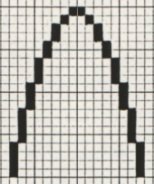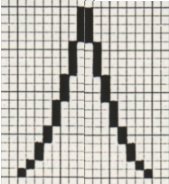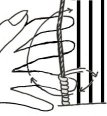To make a line curve, I need to change it's direction. Say I want a gently curved shape.
I need to start with missing one warp, then increase to 2, 3 and so on. To make the shape curve wider I repeat steps, like: 1,1,1,2,2,3,3,4 and so on.
|

|
If I need a higher sloping curve, say for a leaf, I need to increase the 'stops' on the same warp at each new pick. (1) and the same applies to an inverted curve (2).
At this stage I suggest to get some graph paper and experiment drawing a free hand shape, for example different shaped leaves, and follow the drawn outlines by filling the squares which mark the spots where you need to turn at each pick. Weave your favorite leaf shape.
|
1
2
|
Sometimes in a design a vertical line is unavoidable, like when weaving the outline of a house wall or in a character when writing is part of the design.
There are different ways of doing this. If I need to be exact, like in a character I simply stop my weft at that line on both sides. This creates a slit, which I sew up after the tapestry is finished. (Some weavers prefer to sew those up at the loom while their weaving is in progress). My other favorite way of weaving a vertical line goes like this. Say I weave with blue on one side and red on the other. ( 1 ) I go with the blue weft and take the first of the "red" warps and go back to my blue line at the next turn. I do this 'overstepping' at every 4th turn. You may need to do it at every second turn if your epi is lower than 10.
It is a good idea to practice weaving slits. Also small areas like using only 2 warps, for example for a leaf stem.( 2 ) In that case it helps to pull the weft down between the two warps every time I go around to ensure that it lays in tightly.
I can also wrap the weft around a single warp ( 3 ) if I need to have a small defined line. This needs extra practice to ensure the weft is wrapped tightly so that it will not squash down when weaving a shape on top of it.
|
1
2
3
|
The other aspect which influences the angle of a line and the softness or steepnes of a curve is the tension of your weft -ppi - picks per inch. In tapestry weaving it is slightly dangerous to count picks (weft rows) unless you use the same yarn as weft for the entire tapestry. If you want to use silk or metallic yarns for special areas, or use acrylic wool too, then the amount of ppi can vary considerably to that of the wool weft. Hence it is a good idea to practice beating the weft down firmly and evenly, and add picks if necessary, rather than risk to have the shape "squashed" by the weaving above it. The selvedges of a tapestry can be difficult since the weft tends to pack more tightly there. You need to adjust your beating to be slightly lighter.
It takes practice to find the happy medium between too tight and too loose beating down. When you get the hang of it, your tapestry will hang nicely too :-)
|
Next page shows (advanced) vertical and horizontal color blending.
|